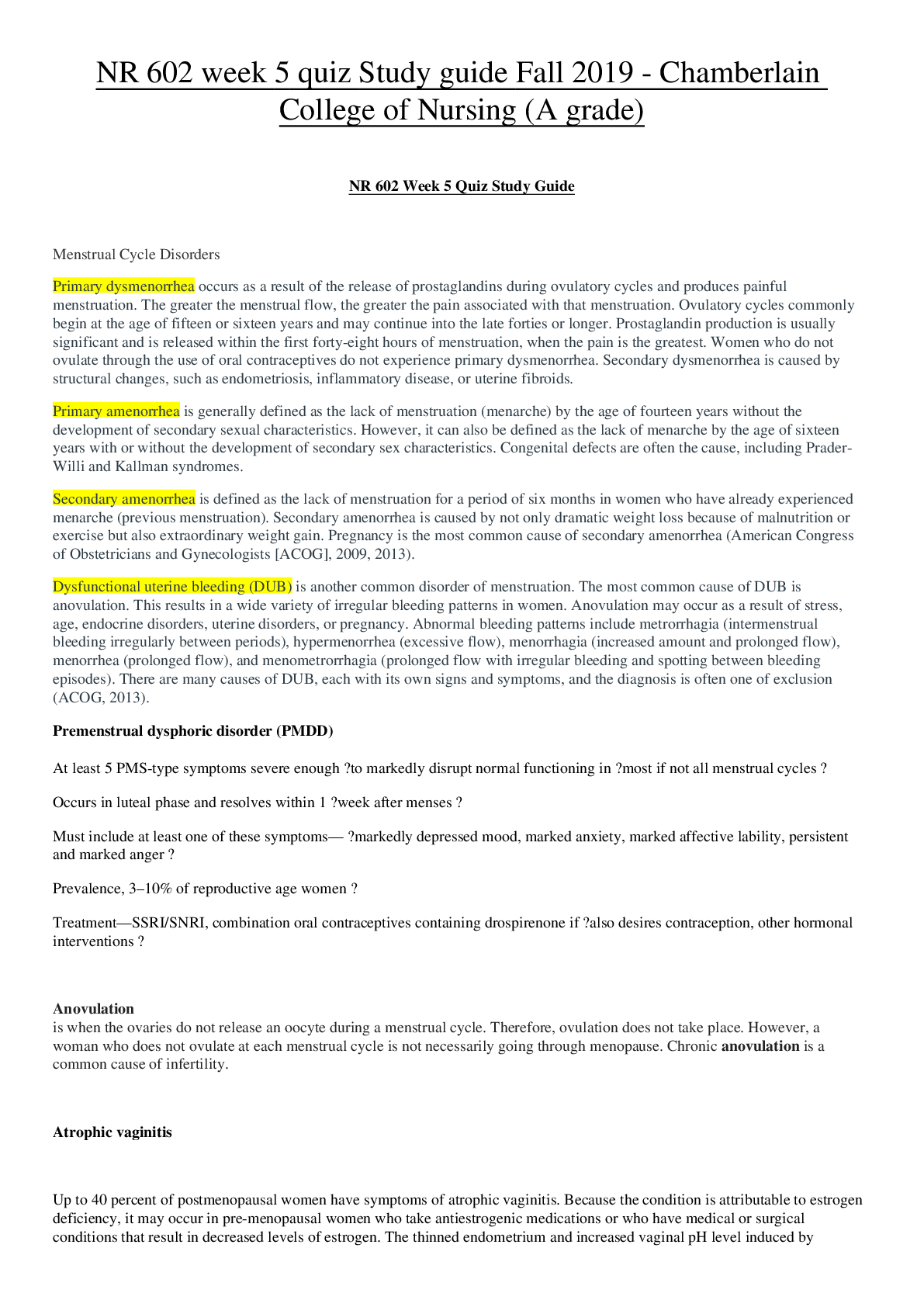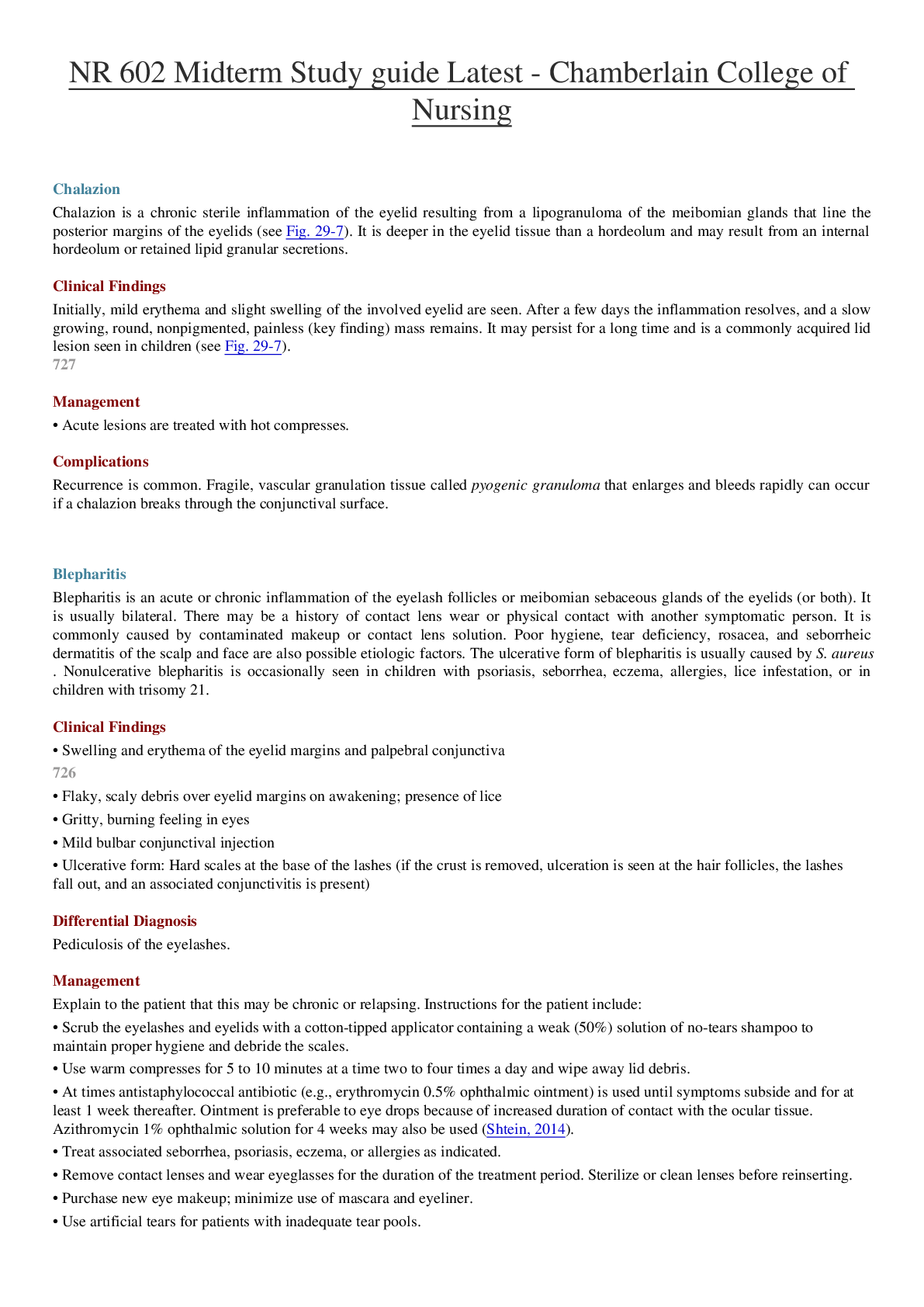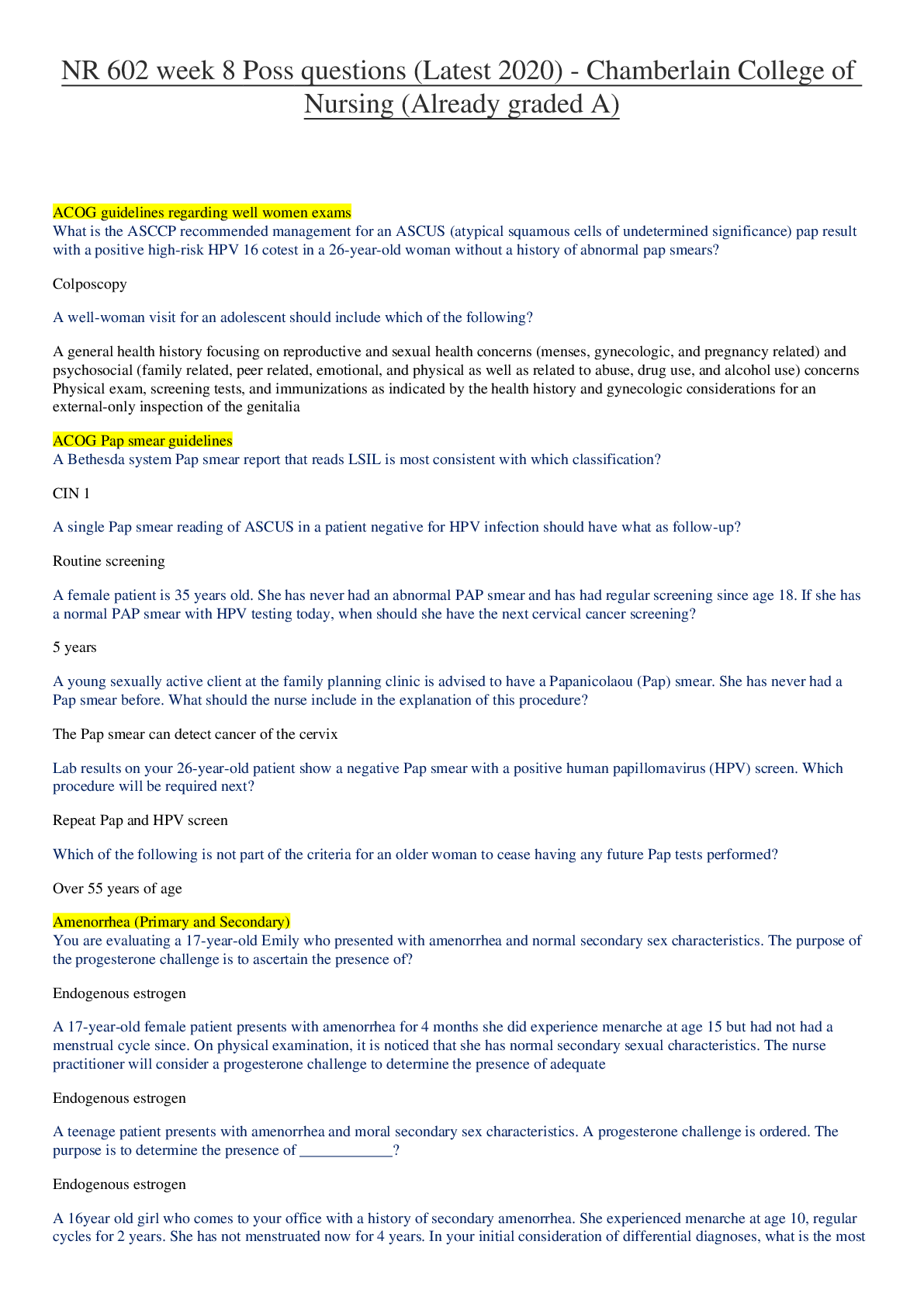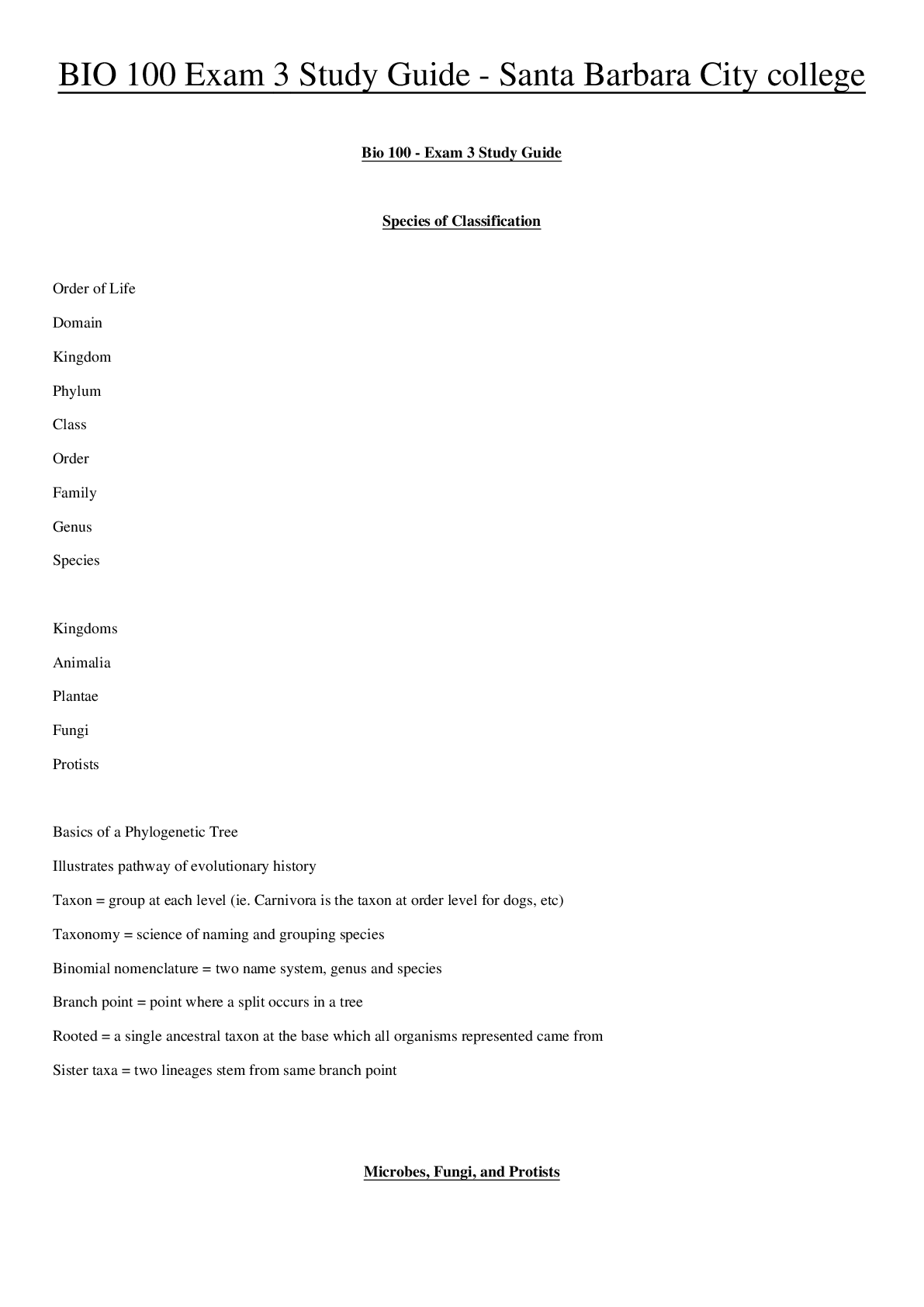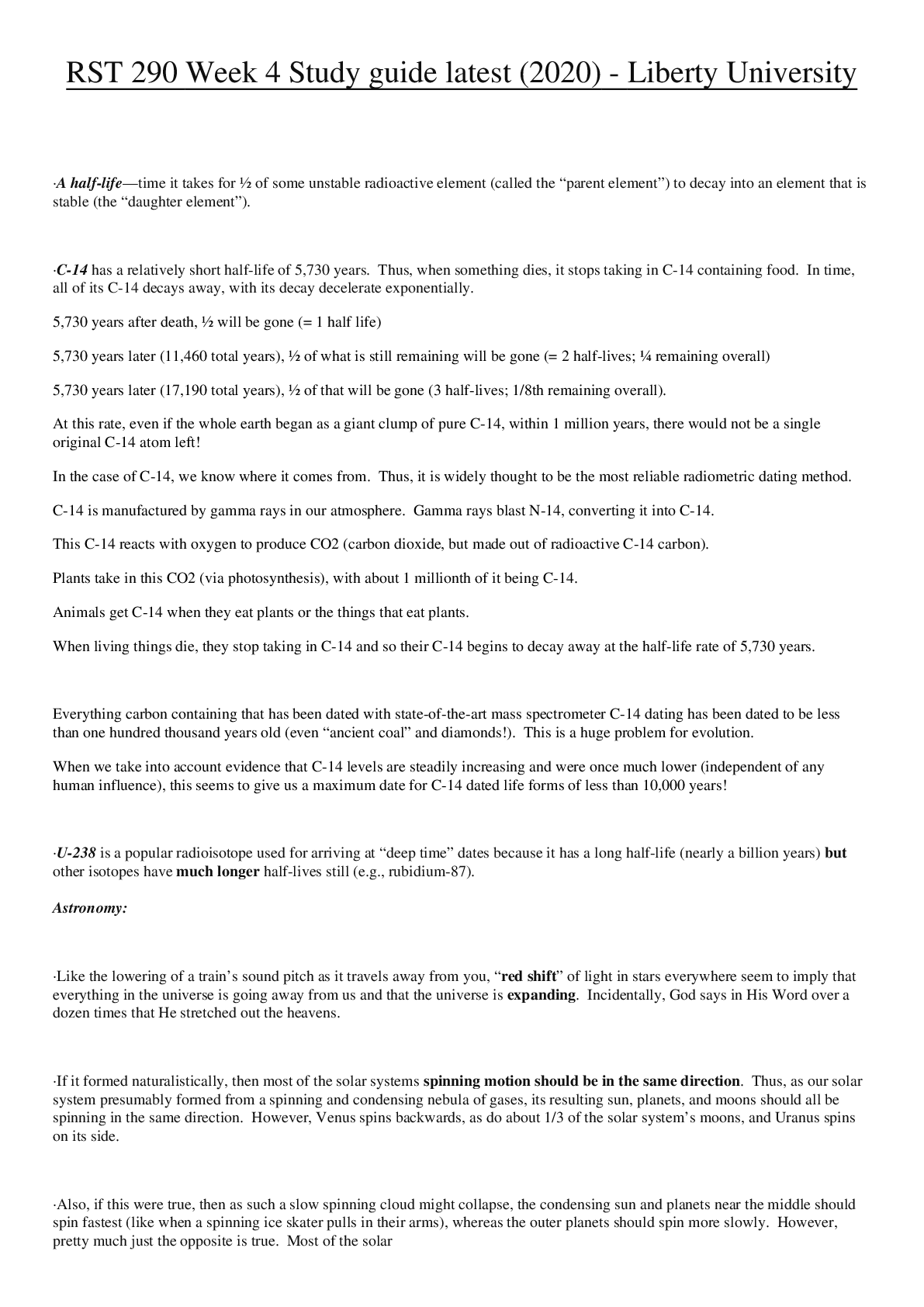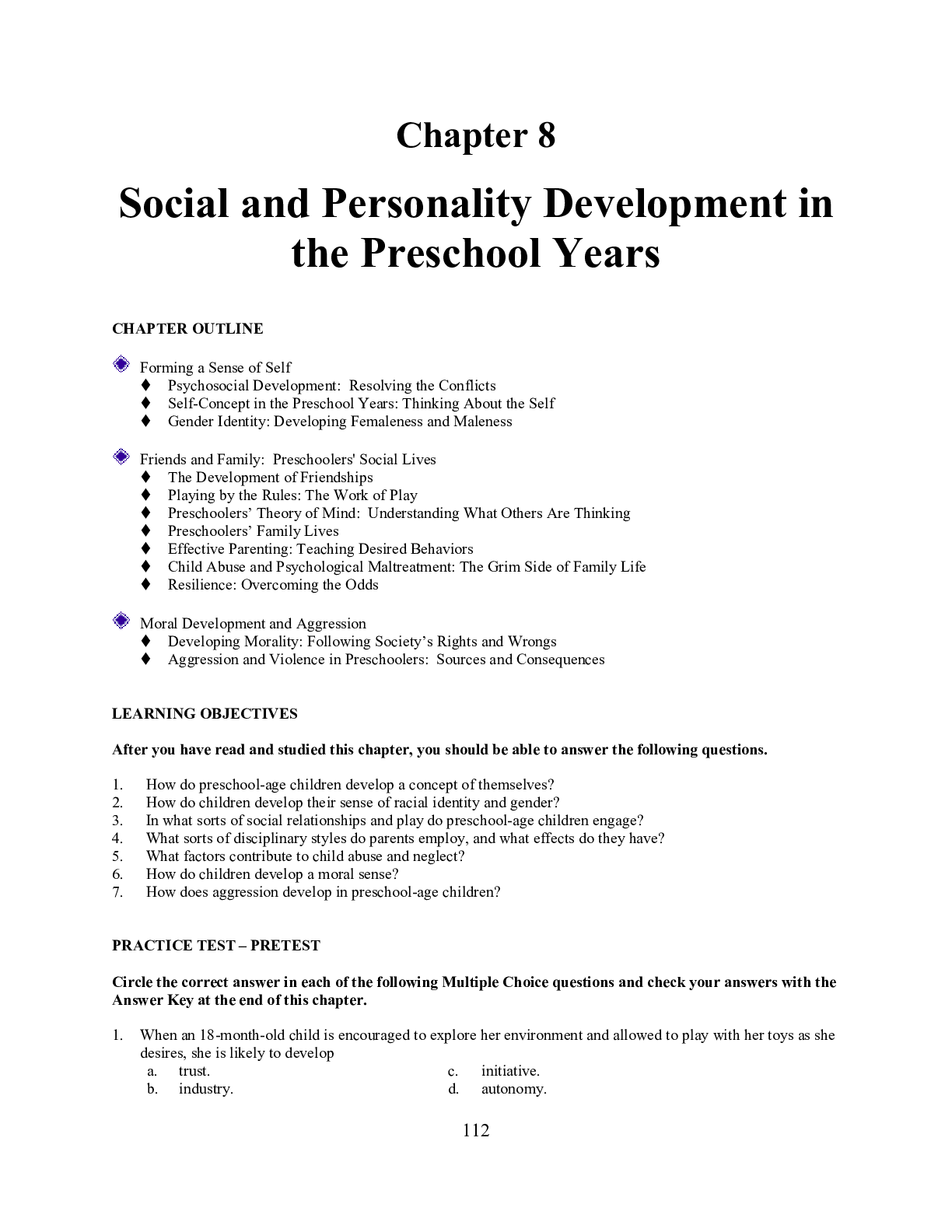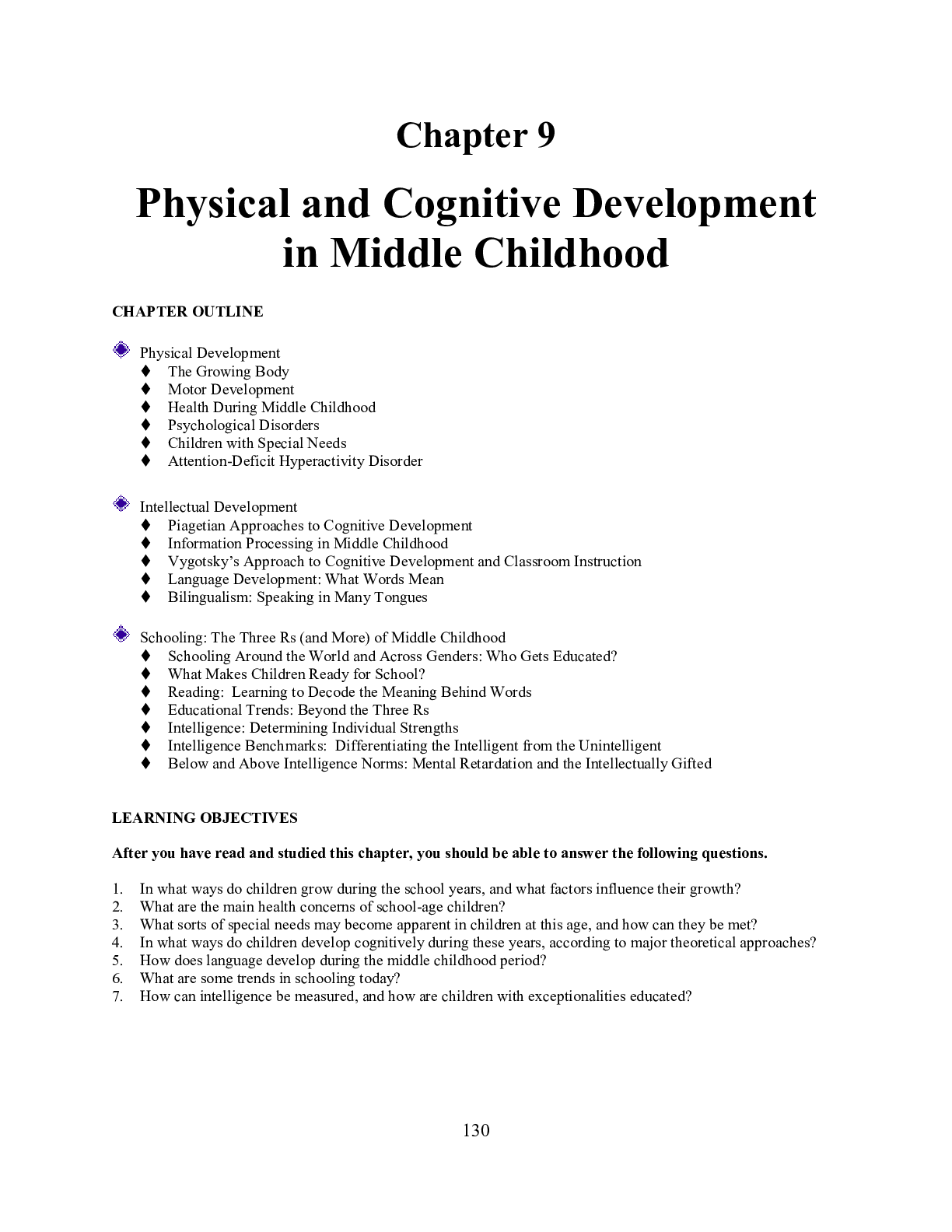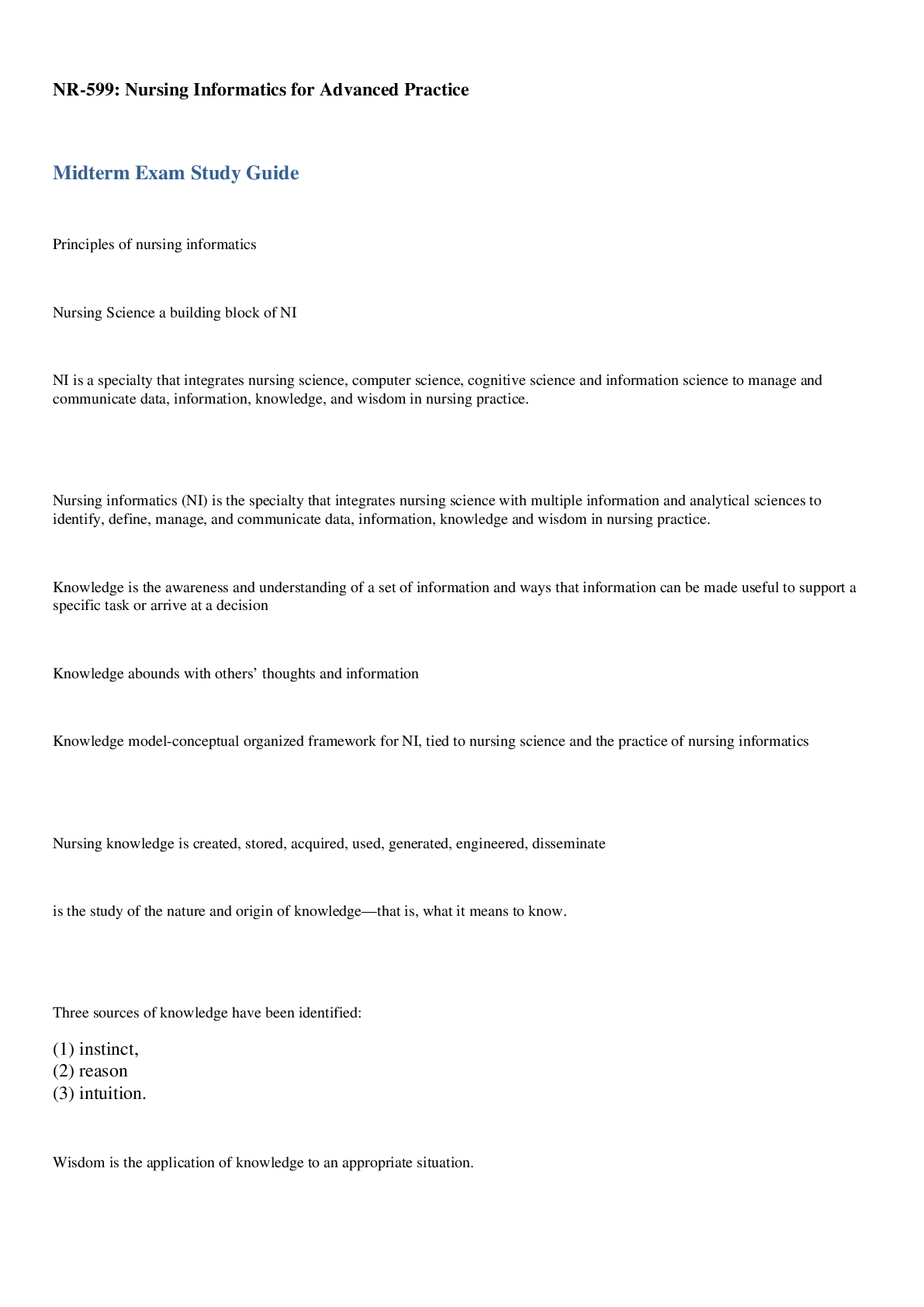Biology > STUDY GUIDE > BIOL 102 Chapter 7 Study guide latest 2020 - Liberty University / BIOL 102 Chapter 7 Study guide lat (All)
BIOL 102 Chapter 7 Study guide latest 2020 - Liberty University / BIOL 102 Chapter 7 Study guide latest 2020
Document Content and Description Below
BIOL 102 Chapter 7 Study guide latest 2020 - Liberty University Chapter 7 Physical and Cognitive Development in the Preschool Years CHAPTER OUTLINE Physical Growth ♦ The Growing Body ♦ The ... Growing Brain ♦ Motor Development Intellectual Development ♦ Piaget's Stage of Preoperational Thinking ♦ Information Processing Approaches to Cognitive Development ♦ Vygotsky’s View of Cognitive Development: Taking Culture into Account The Growth of Language and Learning ♦ Language Development ♦ Learning from the Media: Television and the Internet ♦ Early Childhood Education: Taking the "Pre" Out of the Preschool Period LEARNING OBJECTIVES After you have read and studied this chapter, you should be able to answer the following questions. 1. What is the state of children’s bodies and overall health during the preschool years? 2. How do preschool children’s brains and physical skills develop? 3. How does Piaget interpret cognitive development during the preschool years? 4. How do other views of cognitive development differ from Piaget’s? 5. How does children’s language develop in the preschool years? 6. What effects does television have on preschoolers? 7. What kinds of preschool educational programs are available?96 PRACTICE TEST – PRETEST Circle the correct answer for each question and check your answers with the Answer Key at the end of the chapter. 1. The age at which toilet training takes place has a. been rising over the last few decades. b. been lowering over the last few decades. c. stayed steady over the last few decades. d. become unpredictable over the last few decades. 2. What is the most frequent health problem during the preschool years? a. flu c. mumps b. rubella d. common cold 3. Left hemisphere of the brain is to _____, as the right hemisphere of the brain is to _____. a. music; language competence b. verbal competence; music c. recognition of patterns and drawings; spatial relationships d. spatial relationships; recognition of patterns and drawings 4. Drawing a picture is an example of a(n) a. fine motor skill. c. adaptive motor skill. b. gross motor skill. d. functional motor skill. 5. Most children show a clear-cut preference for their left or right hand (handedness) by a. the end of the preschool years. c. early infancy. b. toddlerhood. d. late infancy. 6. According to Piaget, the preoperational period of cognitive development occurs during a. infancy. c. the grade school years. b. the preschool years. d. adolescence. 7. Which of the following is NOT a feature of preoperational thought? a. conservation c. centration b. intuitive thought d. symbolic function 8. Mental processes that are logical and organized are called a. symbols. c. schemas. b. concepts. d. operations. 9. A child is playing hide-and-seek and puts a toy in front of her face. She thinks no one can see her because she cannot see past the toy. This illustrates what aspect of preoperational thought? a. centration c. egocentricity b. artificialism d. irreversibility 10. When a child understands that quantity is unrelated to the arrangement and physical appearance of objects, he has an understanding of a. functionality. c. intuitive thought. b. conservation. d. mastered seriation. 11. Brahman understands how nouns, verbs, adjectives, and prepositions go together to form complete sentences. He has learned about a. syntax. c. semantics. b. cognition. d. pragmatics.97 12. Preschool education is viewed differently in China, Japan, and the United States. Research has found that in Japan parents view preschool as a way of a. teaching discipline. b. giving children basic academics. c. making children more independent and self-reliant. d. giving children the opportunity to be members of a group. 13. Kali is a preschooler. Statistically speaking, she is at greatest danger from a. illness. c. nutritional problems. b. lead poisoning. d. accidents. 14. Which of the following is NOT a guideline for keeping preschoolers healthy? a. Avoid contact with those who are ill. b. Follow an appropriate schedule for immunizations. c. Adhere to a strict sleep schedule. d. Encourage exercise. 15. Who proposed that children as young as 3 can easily tell the difference between rows of two and three animals regardless of spacing? a. Gelman c. Vygotsky b. Piaget d. Elkind 16. Four-year-old Michelle is most likely to be able to a. jump a distance of 24 to 33 inches. b. make a running jump of 28 to 36 inches. c. easily hop a distance of 16 feet. d. descend a stairway alternating feet. 17. The aspect of language that relates to communicating effectively and appropriately with others is a. private speech. c. grammar. b. social speech. d. pragmatics. 18. Marcus believes he knows how to change a tire on his father’s car even though he has never been shown how to do so, and he is confident in this knowledge. This is an example of a. centration. c. logical relations. b. conservation. d. intuitive thought. 19. Memory for particular events in one’s own life is a. categorical. c. conceptual. b. autobiographical. d. intellectual. 20. Providing clues to children and helping them to frame a task is a. zoning. c. conserving. b. scaffolding. d. parenting. KEY NAMES Match the following names with the most accurate description and check your answers with the Answer Key at the end of this chapter. 1. ___ T. Berry Brazelton a. poverty and language 2. ___ David Elkind b. flexible toilet training - - - - - - - - - PRACTICE TEST – POST TEST Circle the correct answer for each Multiple Choice question and check your answers with the Answer Key at the end of the chapter. 1. The eustachian tube in the ear moves during the preschool years from a position that is almost parallel to the ground at birth to a more angular position. This change can lead to a. hearing loss. c. a decrease in ear infections. b. enhanced hearing. d. an increase in frequency of earaches. 2. As a child grows, the hemispheres of the brain become specialized for specific functions. This process is called a. ossification. c. lateralization. b. myelination. d. regionalization. 3. The part of the brain that controls balance and movement is the a. reticular formation. c. cerebellum. b. myelination . d. lateralization. 4. Which of the following correctly describes the differences in lateralization of the brains of men and women? a. Men show greater lateralization of language in the right hemisphere, whereas females show greater lateralization of language in the left hemisphere. b. Men show greater lateralization of language in the left hemisphere, whereas females show greater lateralization of language in the right hemisphere. c. Men show greater lateralization of language in the left hemisphere, whereas language is more evenly divided between the two hemispheres for females. d. Women show greater lateralization of language in the left hemisphere, whereas language is more evenly divided between the two hemispheres for males. 5. Carlos weighs 35% more than peers of his same age and height. He would be classified as a. obese. c. developmentally delayed. b. an average male. d. developmentally advanced. 6. Exposure to lead has been linked to problems in the following area EXCEPT a. verbal processing. c. spatial reasoning. b. auditory processing. d. hyperactivity and distractibility.107 7. What percent of children are left-handed? a. 5% c. 15% b. 10% d. 25% 8. Jamie is unable to use logical and organized mental processes, but she is able to use symbolic thinking for internal pictures of the world. According to the cognitive development theory of Piaget, what stage of development is she in? a. sensorimotor stage c. formal operational stage b. preoperational stage d. concrete operational stage 9. Five-year-old Amy is shown two rows of marbles, one with eight marbles that are spaced closely together, and the other with five marbles spread out to form a longer row. Amy says that the spread out row of five marbles has more marbles than the shorter row of eight. This reflects what aspect of preoperational thought? a. centration c. egocentricity b. artificialism d. operations 10. A 4-year-old child is asked to draw a pencil falling. The child draws the pencil vertical and then horizontal, with no stages in between. This child shows that he does not understand a. centration. c. egocentricity. b. artificialism. d. transformation. 11. Who proposed the zone of proximal development? a. Piaget c. Vygotsky b. Erikson d. Chomsky 12. How many hours of TV does an average preschooler watch in a week? a. 5-10 hours c. 15-20 hours b. 10-15 hours d. 21 or more hours 13. Which developmental psychologist believes that society tends to push young children so hard that they experience excessive stress? a. Piaget c. Vygotsky b. Elkind d. Chomsky 14. What federal program was designed to promote future academic success of preschoolers? a. Head Start c. School child care b. Montessori schools d. Sesame Street 15. Which of the following children is most likely to be injured? a. an Asian American girl c. a boy living in an urban area b. a girl living in the country d. a boy living on a farm 16. By age 5, children’s brains weigh _____ % of average adult brain weight. a. 50 c. 80 b. 70 d. 90 17. What percentage of preschoolers between the ages of 4 and 6 have used a computer? a. 10 c. 20 b. 50 d. 70 18. The information processing approach focuses on a. the kinds of mental programs children invoke. b. the strength and focus of intuitive thought. c. the zone of proximal development. d. conservation and centration.108 19. Research into children’s eyewitness testimony indicates that preschool children a. are not easily influenced by adults’ suggestions. b. purposely lie to adults. c. are not able to remember accurately. d. usually believe their false memories are accurate. 20. Aisha is a 1-year-old. According to the American Academy of Pediatrics, she should watch no more than _____hour(s) of television per day. a. 0 c. 1-2 b. 1 d. 3-4 LEARNING OBJECTIVES REVISITED 1. What is the state of children’s bodies and overall health during the preschool years? • In addition to gaining height and weight, the bodies of preschool children undergo changes in shape and structure. Children grow more slender, and their bones and muscles strengthen. • Children in the preschool years are generally quite healthy. Obesity in these years is caused by genetic and environmental factors. The greatest health threats are accidents and environmental factors. 2. How do preschool children’s brains and physical skills develop? • Brain growth is particularly rapid during the preschool years, with the number of interconnections among cells and the amount of myelin around neurons increasing greatly. The halves of the brain begin to specialize in somewhat different tasks—a process called lateralization. • Both gross and fine motor skills advance rapidly during the preschool years. Gender differences begin to emerge, fine motor skills are honed, and handedness begins to assert itself. 3. How does Piaget interpret cognitive development during the preschool years? • During the stage that Piaget has described as preoperational, children are not yet able to engage in organized, formal, logical thinking. However, their development of symbolic function permits quicker and more effective thinking as they are freed from the limitations of sensorimotor learning. • According to Piaget, children in the preoperational stage engage in intuitive thought for the first time, actively applying rudimentary reasoning skills to the acquisition of world knowledge. 4. How do other views of cognitive development differ from Piaget’s? • A different approach to cognitive development is taken by proponents of information processing theories, who focus on preschoolers’ storage and recall of information and on quantitative changes in information processing abilities (such as attention). • Lev Vygotsky proposed that the nature and progress of children’s cognitive development are dependent on the children’s social and cultural context. 5. How does children’s language develop in the preschool years? • Children rapidly progress from two-word utterances to longer, more sophisticated expressions that reflect their growing vocabularies and emerging grasp of grammar. • The development of linguistic abilities is affected by socioeconomic status. The result can be lowered linguistic—and, ultimately, academic—performance by poorer children.109 6. What effects does television have on preschoolers? • The effects of television are mixed. Preschoolers’ sustained exposure to emotions and situations that are not representative of the real world have raised concerns. On the other hand, preschoolers can derive meaning from such targeted programs as Sesame Street, which are designed to bring about cognitive gains. 7. What kinds of preschool educational programs are available? • Early childhood educational programs, offered as center-based or school-based child care or as preschool, can lead to cognitive and social advances. • The United States lacks a coordinated national policy on preschool education. The major federal initiative in U.S. preschool education has been the Head Start program, which has yielded mixed results. [Show More]
Last updated: 2 years ago
Preview 1 out of 17 pages
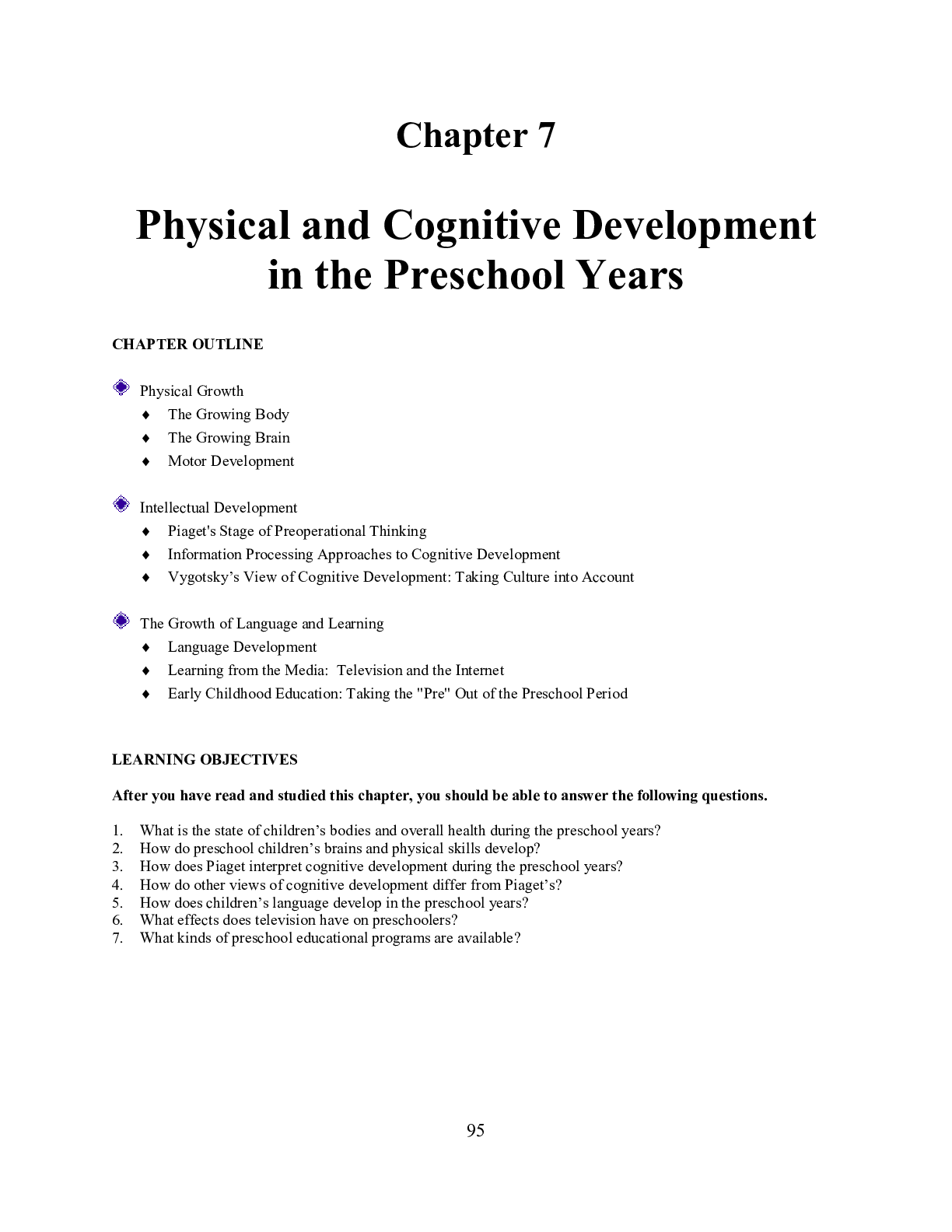
Buy this document to get the full access instantly
Instant Download Access after purchase
Buy NowInstant download
We Accept:

Reviews( 0 )
$12.50
Can't find what you want? Try our AI powered Search
Document information
Connected school, study & course
About the document
Uploaded On
May 28, 2020
Number of pages
17
Written in
Additional information
This document has been written for:
Uploaded
May 28, 2020
Downloads
0
Views
118







